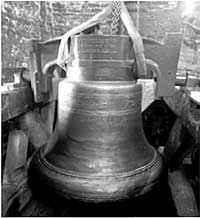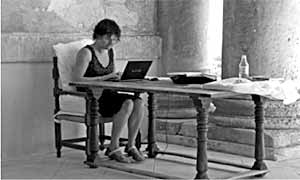News
REPORT FROM THE CHAIR OF COUNCIL
It was a delight to see so many Society members at the Spring Meeting and AGM, which was held at Flintham Hall. We extend our thanks to Sir Robert Hildyard for graciously hosting us and to Sue Clayton for bringing her local expertise to bear in organising the day. We took the occasion to mark the 400th anniversary of our eponymous founder, Dr Robert Thoroton (1623-1678), whose Antiquities of Nottinghamshire (1677) is regarded as the first published history of the county. In the 125+ years of the Thoroton Society, we have generated a good deal of original research of our own.
When I succeeded as Chair of Council, in the summer of 2020, I was keen to revive and bring to completion the project for digitising the entire back-run of Transactions, and to make this material as widely available as possible. In the intervening three years, Andy Nicholson, our talented webmaster, has worked single-handed at the intricate and time-consuming process of digitising the complete run of Transactions to the high standards required for long term preservation and conservation of this material. Thanks to Andy, the Society is now at a point where its Transactions can be accessed freely through the Archaeology Data Service website. We will be releasing more recent volumes in stages after members have received priority access to the latest high-quality research on Nottinghamshire’s history and archaeology. Just as importantly, the Society’s archive collection at Nottinghamshire Archives (known by the call reference DD/TS) has recently been sorted in order to bring its wide and miscellaneous content up to date. The Society has been an important curator of original material since its inception in 1897, but these days refers potential depositors directly to Nottinghamshire Archives (which is run by Inspire on behalf of Nottinghamshire County Council), who can advise on the appropriate methods for depositing precious sources in perpetuity.
Digital access to the historic run of Transactions and the re-ordering of the Society’s own archive opens up tremendous possibilities for ongoing research, as well as the future promotion of the Society and (we hope) the expansion of its membership. For example, the Society’s Research group, which has been less active in recent times (largely as a result of COVID and the death of John Wilson), could readily consider exploring some of the treasures of the Society’s archive collection, identifying areas for research, manuscripts worthy of publication in the Record Series, or material which can be enriched with more detailed cataloguing of subjects, places and events. Thanks to the continuing generosity of Geoffrey Bond, and the match-funding provided by the Society, the Geoffrey Bond and Thoroton Society Research Award has funding to support a range of projects for another year. Have members considered applying for funds to support work on some of our own collections? Given the possibilities for making the results of that research widespread, through the Society’s newsletter, e-bulletin, and Transactions, as well as the Record Series and Heritage Gateway website, the possibilities for tying together different elements of our activity are greater than ever before. Please do consider making an application for funds, or else your ideas for a Thoroton research project, drawing on our rich and underused collections. Likewise, for those of you who are aware of, or concerned about, planning applications or developments which threaten historic buildings and amenities or heritage assets in your locality, do remember the Society’s Response Group, ably led by Barbara Cast, which continues to undertake a lot of valuable work in the Society’s name, defending local sites from injudicious planning applications. The Response Group relies on having subjects of concern brought to its attention and would welcome more support, not just in bringing issues to its notice, but in providing background information to enable the Society to write its letters of response. Whilst we cannot guarantee success, the Society’s voice continues to matter in these issues, and we can point to a number of recent examples where our intervention has helpfully amplified concerns which have been registered in other (often influential) quarters.
In these and other ways, I hope that the Society continues to uphold the memory of Dr Thoroton, in researching and publicising the history, archaeology and antiquities of Nottinghamshire, as we enter upon the reign of King Charles III.
Richard Gaunt, Chair of Council
THE BELLS, THE BELLS! AGAIN

Our friends at St Mary’s Church at Car Colston are progressing with their ambitious projects to better present and interpret the west end of the church and also to increase and renew its wonderful ring of bells. The four original bells returned from Taylors Foundry, Loughborough, on 22nd March after fifteen weeks of a full restoration and returning, plus new steel headstocks. St Mary’s bells had not been rung for over 40 years as they had been declared unsafe because the wooden headstocks which held them in place were rotting. These bells have now been joined by two new treble companions and the first trial ring of all six bells took place on 20th April - performed by the newly formed enthusiastic team of bell ringers.
These bells have now been joined by two new treble companions and the first trial ring of all six bells took place on 20th April - performed by the newly formed enthusiastic team of bell ringers. The whole process of the bells’ renewal, of their hoisting, one by one, into the tower with words of blessing from the Rector, and their voices being heard together for the first time, were once-in-a-century occasions, greatly enjoyed by all who had gathered there!
The oldest bell was cast about 1480 by a Nottingham bell-founder and is the heaviest. The other bells are by Nottingham founder George Oldfield and date from 1633 and the fourth bell dates from 1872 and, like the newcomers, was cast by Taylors of Loughborough. The work to the bells and the acquisition of the two new ones is being financed through a fundraising appeal and there have been many generous individual donors and also donations from organisations including the Southwell and Nottingham Diocese Association of Bellringers, Nottinghamshire Historic Churches Trust and Benefactor Trust - and also the National Heritage Lottery Fund.
St Mary’s is a building which the Society has very much taken to its heart not only as the church Dr Robert Thoroton attended and where he was buried, but also where we enjoyed a memorable visit and where we have found very good friends, and now, colleagues. A group from the Society is involved with the St Mary’s team in the other project which will ensure that visitors will be able to gain a better understanding not only of the church and its history but also of the importance of Dr Thoroton to the county and his place in history. The plan is to reposition some pews and heating pipes to allow better access to the architecturally and historically important tomb of Dr Robert Thoroton. When this work is approved through Diocesan processes the west end of the church will not only be well resourced with its six sounding bells but also have an attractive area where information on the church’s history can be readily found. This is where the Thoroton Society is assisting in the composition of an information and heritage board detailing the life and times of Dr Thoroton.
Barbara Cast
Obituary
Elain Harwood (1958 -2023)

Elain Harwood, who died suddenly last month, will be best known to members of the Thoroton Society as the author of the Pevsner City Guide - Nottingham published in 2008 and as an enthusiastic and original speaker with a special interest in the architecture of the twentieth century. This interest was sparked initially by the Nottingham Playhouse, designed by Peter Moro, though it would be many years until this became her especial interest. Elain was born in Beeston in 1958. She attended Bramcote Hills Grammar School and went on to study History at Bristol University. She joined the staff of the newly created English Heritage as co-ordinator for the Resurvey of Listed Buildings in the 1980s. She remained at English Heritage (then Historic England) as a London Historian with a wide remit.
She assisted David Jacques with the compilation of the Gardens Register, published an article on the 16th century Moreton Corbet Castle in the first English Heritage Historical Review (Vol. 1, 2006) and made a special study of Theatres and Cinemas becoming a leading light in the Cinema Theatre Association.
But it was her appointment in 1998 as Secretary and Caseworker for the Post-War Steering Group, set up to evaluate the possible listing of buildings built after 1945, that Elian really reconnected with her interest in the late twentieth century. Elain was at her best when fighting to convince the members of this group of experts of the special importance of an experimental construction system or an American style office complex, like Boots D90. The work of this group led to the publication by Elain of a number of books which illustrated the buildings selected for listing. It also led to her far greater involvement with the Twentieth Century Society organising lectures, conferences and foreign tours. In 1998 she became one of the editors, with Alan Powers, of The Journal of the Twentieth Century Society, and one of its most regular contributors. In 2011 she published a volume in the RIBA’s ‘Twentieth Century Architects’ series on Chamberlin, Powell and Bon.
Elain completed her PhD on the South Bank under Professor Tim Mowl at Bristol University in 2010 and in 2015 she published her major work, Space, Hope and Brutalism, English Architecture 1945-1975, which won the prestigious ‘Alice Davis Hitchcock medallion’ in 2016. Often referred to by Elain as the ‘Bumper Book of Brutalism’ it is certainly the heaviest book on my shelves and an outstanding achievement. Since then more books have followed, including Art Deco Britain, Buildings of the Inter-War Years (2019) and Mid-Century Britain, Modern Architecture 1938-1963 (2021). In 2022 she was made an honorary fellow of the RIBA. Elain was not only a dedicated historian but also a passionate photographer, an enthusiastic cyclist, a collector of vinyl and an inveterate traveller. But most importantly she was fun to be with and adventurous; whether scrambling through a roof-light to get on to the roof of a country house or Roller Blading on Venice Beach, Elain was always willing to have a go. Elain was a good friend who will be sorely missed by her comrades, colleagues and all who knew her.
Pete Smith